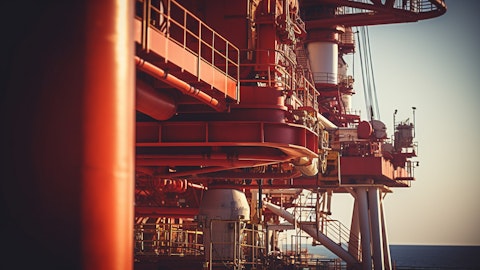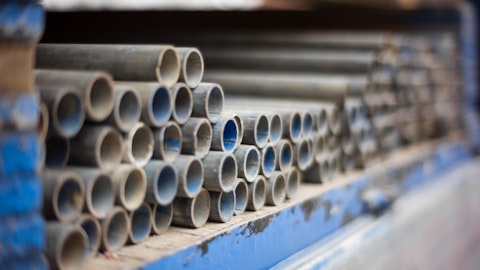Luca Zanotti: Yes, Paolo. Thank you. Hi, Alessandro. On the DUCs? Yes. You are right. In March 2024, according to the Energy Information Administration, we had a number of DUCs that was the lowest over the last 10 years. For example, if you just go back 5, 4 years, and in Permian we had 3,200 DUCs, and in March we had slightly less than 900. So you might think that here there is a potential upside, and you may be right. This upside is not in our focus, and we may have it. On the other hand, I do believe that the business model by which E&Ps were building large inventory of DUCs given the capital discipline is no longer on the table. But you are right. There are two aspects that may play on the upside, which is the number of blocks [ph], one, and also the fact that with these lower rate activities, the U.S. is maintaining crude production above the 13 million barrel per day, which is pretty significant.
Alessandro Pozzi: Okay. Thank you very much.
Operator: Thank you. One moment for our next question. Our next question comes from the line from Marc Bianchi from TD Cowen.
Marc Bianchi: Hi. Thank you. I’d like to just first clarify, Paolo, if we could, the progression you outlaid on the margins. I think I heard that second quarter could be below 25%. The second half would be between 20% to 25% with the third quarter approaching 20%. Did that capture it?
Paolo Rocca: Yes. In the first half we will be slightly higher than 25%, because we had a good first quarter. In the second half as you are saying for the visibility that we have we will be in this range, and in the third quarter because of the reduction of seamless we will probably be above 20%, but let’s say slightly above 20%, 25%, let’s say, what we can be such today.
Marc Bianchi: Okay. That’s helpful. Thank you. The press release talked about the TenarisShawcor project that contributed to first quarter. Could you maybe discuss how much of a contribution that was and help us think about what maybe normalized contribution from that business should be as we progress?
Paolo Rocca: Thank you, Marc. The Shawcor business has ups and downs depending from large projects, it’s a business that depends on the relevant contract for relevant projects around. But I would ask Gabriel to give you the view on how we see the perspective of Shawcor for the foreseeable future.
Gabriel Podskubka: Yeah, thank you, Paolo. Yeah, good morning, Marc. Yes, indeed Shawcor has contributed importantly to the results of the first quarter given the last stage the tail of a large concrete weight coating project in Mexico in the Altamira region. So this had a contribution of about $80 million in revenue specifically in the first quarter for this project that we will not carry further down in the year. But we are very pleased with the Shawcor acquisition. The brand of Shawcor is very well-recognized as a global leader, a global footprint of facilities and at the centers to track record and product knowledge that complements and strengthens very well the position of the Tenaris in the offshore segment. As a matter of fact, Paolo announced in the opening remarks the recent order related to the insulation coating in Guyana development, more than $100 million in insulation coating with the good margins and contributions.
So we expect the Shawcor business to continue supporting revenues on our position in the offshore segment. I would normalize annual revenues in Shawcor after this Altamira project in the range of $250 million to $300 million annually. This would be a running rate where we see Shawcor contribution going forward.
Paolo Rocca: Thank you, Gabriel.
Marc Bianchi: Wonderful. Thank you very much. I’ll turn it back.
Operator: Thank you. One moment for our next question. Our next question comes from the line of Dave Anderson from Barclays.
David Anderson: Hi, good morning. I wanted to ask a bit about the Middle East and how that’s going to impact your volumes kind of thinking about kind of 25 and beyond. You just noted a 2-year extension on the UAE Rig Direct, but I believe that contract has actually been – the volumes have been fairly slow, because they’ve been working down a lot of the inventories. So I’m curious if you can start to see that spike and start to pick up over the next couple of years. And secondarily, you also mentioned unconventional in Saudi. And that looks like a massive opportunity there. And I’d love to understand a little bit from your perspective on how you see that changing thing. Did your foreign wells, I believe, are quite a bit more OCTG-intensive than even the U.S. onshore conventional? If you could talk about those two markets, please? Thank you.
Paolo Rocca: Yeah. Thank you, Dave. Also on this question, I will ask Gabriel, an overview for Middle East in general and unconventional in Saudi, which also we share, the view that is a very relevant development for Saudi, it’s important for us.
Gabriel Podskubka: Yeah. Thank you, Paolo. Good morning, Dave. Yes, what we see in the Middle East is that the daily activity remains strong. We see continued investment in expansion of capacity, both in oil and in gas, with a very positive momentum. Saudi clearly remains the brightest spot during the last quarter. The Kingdom announced the revised upwards the target of gas production increase for 2030. Now, we are targeting an increase of 60%, previously target was 50%. So we see that the drilling in gas, onshore gas, related also to the unconventional that you’re mentioning, Dave, will more than offset the decrease in the offshore rigs related to oil that were also announced during the last quarter. So, overall, the Saudi strong level of activity, also the CapEx guidance for 2024 for the year of Saudi was given a range that is importantly higher than 2023.
So we believe that with the backlog that we have, with the position that we have in the country for OCTG and pipelines, Tenaris’ well-positioned to remain delivering strong shipments into the Kingdom. The Emirates is also expanding. Paolo mentioned the extension of our long-term agreement with ADNOC. We extend it for another 2 years. We had the chance to incorporate other coating services, digital services, and also expanded our jobs [ph] range in the Emirates, where we have our facility up and running. So, overall, we also see strength coming from the Emirates in the Middle East. And last but not least, Qatar, also during the quarter made an announcement about an expansion, a further development expansion of their LNG project. This is a Northwest field project.

